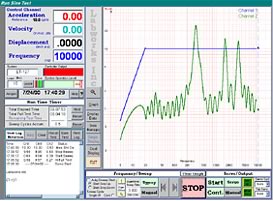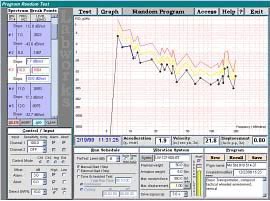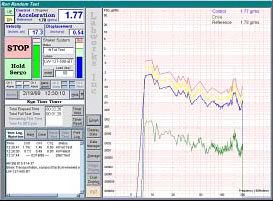AMAZON multi-meters discounts AMAZON oscilloscope discounts
Shaker controllers are units designed to control shaker tables and related equipment. The simplest types of shaker controllers are controlled manually and depend on a technician or operator to read and evaluate the feedback signal, and then adjust the amplifier signal input voltage accordingly. A system such as this may be as simple as a by a voltmeter-monitored sine-wave signal generator connected to a vibration sensor an accelerometer. Hence, it’s up to the technician to manually adjust the gain for changes in frequency or desired level specifications.

Above: A manual sine controller from Labworks.
The manual method is inefficient because most modern accelerometers need a constant current source/buffer amplifier and most voltmeters read in either average or RMS voltage for AC signals. Hence, it can be difficult to read and adjust for peak acceleration with manual monitoring and recording. For example, errors can crop in if the accelerometer has a sensitivity that's not convenient for conversion to voltage. Random acceleration may be monitored this way due to the RMS nature of most random-acceleration specifications. Nevertheless, an RMS-calibrated voltmeter will throw in another error when monitoring Gaussian signals. If the vibration specification involves displacement, it becomes virtually impossible to use this (manual) method.
The solution is to use automated shaker controllers.

Above: A computerized, automated shaker controller
system. This is a more elaborate (and more costly) solution than a manual
controller.
Shaker controllers vary in complexity, but normally provide feedback calibrated in acceleration and displacement units useful to vibration and /or shock testing. Simple, manual units offer frequency and gain adjustment while providing a calibrated acceleration signal in peak G’s. More sophisticated units feature automatic servo controlled levels with programming and frequency-sweep capabilities. High-end (most costly) controllers make extensive use of computer software and advanced technology and can control to almost any specification with multiple, sensors, accelerometers, and more.
The most important specifications for shaker controllers are:
- number of inputs and outputs
- output dynamic range
- output frequency range
- types of testing needed to be performed, including:
- simple outputs (e.g. random Gaussian output signal, classical shock, arbitrary transients)
- more complex signals
- Sine-on-random (test signal where narrowband sine waves are combined with broadband random waves for a complex vibration signal)
- Random-on-random (produces a test signal that has narrowband random waves combined with broadband random waves)
- A shock-response system (calculates the responses of a large number of theoretical, single-degree-of-freedom
Below are some screen captures from Labworks computerized shaker-controller system. They portray just how comprehensive fully-automated, software-driven shock and vibration testing can be:
 Sine Test Programming Screen |
 Sine Test Run Screen |
 Random Test Programming Screen |
 Random Test Run Screen |